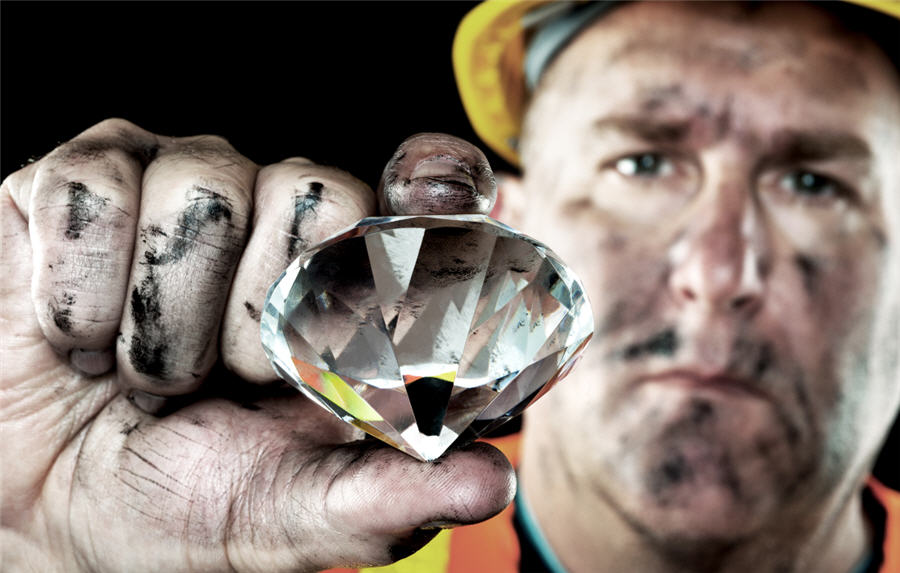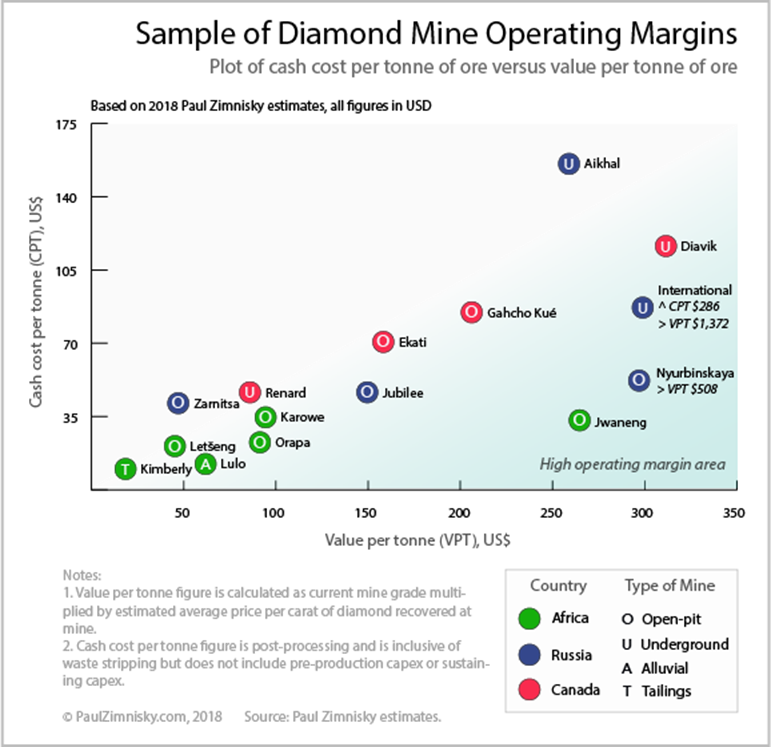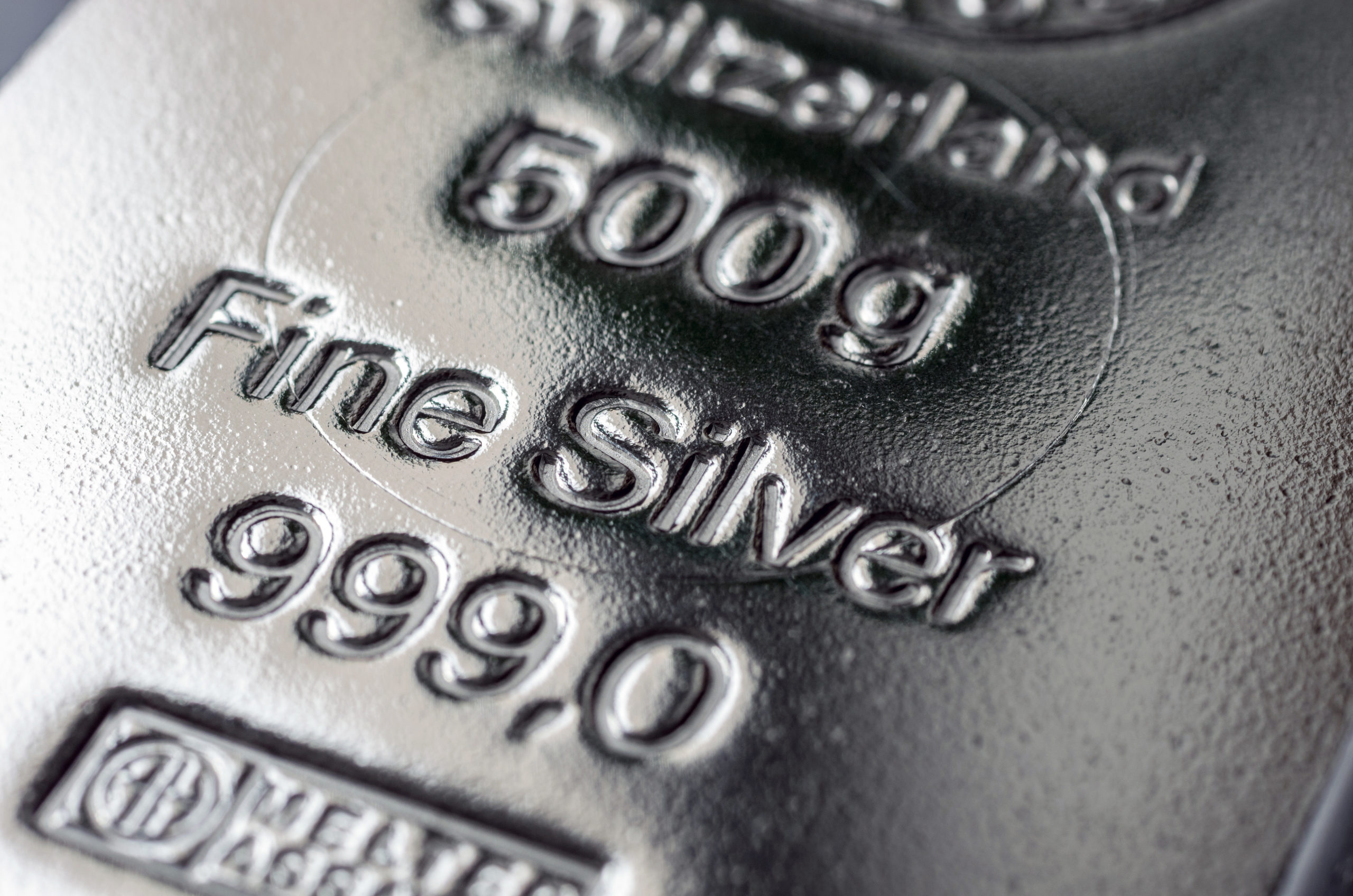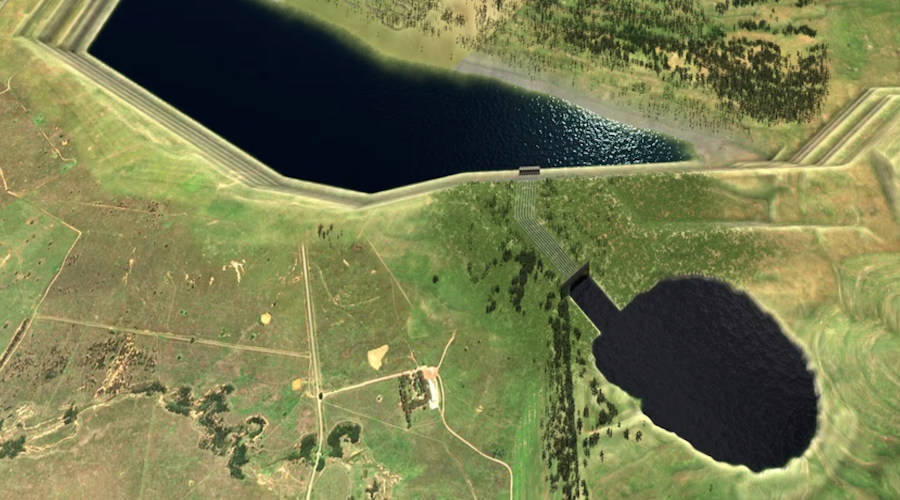Replenishing economic diamond resources, a daunting task for miners

Given that most of the high-economic diamond deposits in the world have already been put into production, diluted via expansion, or depleted, going forward the economics of diamond mines will inevitably gravitate towards higher-cost, lower-value operations. Miners are left with a fairly limited decision to replenish their declining resource bases by either discovering or buying greenfield1 projects or expanding their existing legacy mines, thereby elongating the life of mine but typically at lower-quality economics.
The uncertainty surrounding greenfield projects tends to be a risky proposition given the operational complexities of a brand-new mining operation, constantly changing economics based on real world variables, and substantial financing and capital expenditure requirements, especially in the case of Canada’s remote arctic north for example. In addition, geopolitical risk also plays a significant role in the case of jurisdictions like Angola, Zimbabwe, or the DRC. Further, Russia, the largest diamond producing nation in the world, is off-limits to outsiders as the country considerers diamonds a strategic resource.
Expansion projects tend to offer lower risk relative to greenfield projects given that operational, economic, and geopolitical risks have already been experienced, reconciled or at least properly gaged. That said, expansion projects in some cases can be as costly as new mine construction, in the billions of dollars, especially if the project involves a large new open-pit “cut” or transitioning from an open-pit to underground operation.
The figure above provides a sample of current diamond mine operating margins based on 2018 estimates, where operating margin is considered value per tonne of ore at a given mine minus the cash cost to produce a tonne of ore at the mine. The mines falling on the bottom right quadrant of the figure are shown to be of highest margin. In general, mine economics have
gravitated away from the “high margin area” in recent years as most new mines offer lower-quality resources than in the past and legacy mine economics have diminished as the most economic ore has depleted.
Above, value per tonne is calculated as ore grade multiplied by average diamond price per carat and cash cost is the cost to mine and process a tonne of ore inclusive of waste stripping but exclusive of mine construction costs and sustaining capital expenditure. That said, while this analysis provides a glimpse into the economics of a given mine, it only serves as a partial relative analysis since resource size, capital expenditure and geopolitical variables are not factored in.
Given the time value of money and subjective depreciation methods of capital expenditures, i.e. mine construction and capitalized expansion investment, a complete relative profitability comparison of current producing mines is difficult. In addition, variables such as value per tonne of a given mine are constantly changing given the sensitivity to grade which is constantly changing depending on factors such as strip ratio2 and the portion of the ore body being mined, as is the average diamond price which is influenced by the diamond population being produced at a given time. Further, geopolitical factors such as government royalties, taxes and nationalization risk influence a mine’s profitability which can vary greatly depending on the jurisdiction.

Solely based on operating margin as described above, De Beers’3 Jwaneng mine and ALROSA’s (MICEX: ALRS) International and Nyurbinskaya mines are the richest large-scale commercial diamond mines in the world. Jwaneng has been in production since 1982, International 1971, and Nyurbinskaya 2003.
De Beers recently completed an open-pit expansion referred to as “Cut-8” at Jwaneng to extend the life of mine to 2024. After 8 years of construction and a capital expenditure of around $3 billion, “Cut-8” preserves operations at what is easily the most valuable diamond mine in the world. Current Jwaneng tonnage is estimated to be worth over $250 relative to a cash cost estimated to be less than $40 per tonne. In addition, Jwaneng hosts a massive resource of almost 350 million carats. The mine by itself is estimated to account for a 47% of De Beers’ company-wide production by value, and 17% of total global diamond supply by value in 2018. A “Cut-9” at Jwaneng is already being proposed which would further extend the life-of-mine an additional 10+ years.
De Beers is also expanding its largest mine in South Africa, Venetia, going underground by 2022. In nominal terms, the $2 billion project is the largest investment in South African diamond mining history, and will extend Venetia’s mine life to 2046. By the time underground production commences, Venetia will likely be De Beers’ only remaining South Africa diamond mine as the company divested most of its South African portfolio to independent producer Petra Diamonds (LSE: PDL) over the last decade.

New processing plant at the Cullinan diamond mine in South Africa. Source: Petra Diamonds
Petra recently expanded two legacy South African assets acquired from De Beers in 2008 and 2011, the Cullinan and Finch mines, respectively. An expansion project at Cullinan, perhaps the most famous diamond mine in the world having produced the two largest diamonds set in the British Crown Jewels, was completed this year via accessing a richer portion of the ore body and increasing throughput capacity with a new processing plant. Petra’s Finch mine, South Africa’s second largest diamond mine after Venetia, was also expanded to access undiluted ore from new areas of the mine. The projects are estimated to extend both mine lives to 2030.
Cullinan has been in production for over a century, since 1903. Finsch has been in production since 1967. Consequently, the complexities of working with older mines has been apparent as the completion date of both expansion projects was initially delayed, and shortly after operations finally commenced, production guidance was cut at both mines due to lower anticipated grades at Cullinan and a change in mine plan at Finch. While not plotted in the figure above, Cullinan ore is currently estimated to be valued at $53 per tonne versus a cash cost of $16 per tonne; Finsch ore is currently estimated to be worth $61 per tonne at a cost of $28 per tonne.
Russia, estimated to be the largest diamond producer in the world by value and volume in 2018, hosts 12 active kimberlite mines, 11 of which are owned by ALROSA. While some of these mines are the most economic diamond mines in the world, many have been in production for almost a half a century and their age is beginning to show.

Miners being transported underground at the Aikhal mine in Russia. Source: ALROSA
In operation since 1957, ALROSA’s Mir mine sustained a fatal accident in mid-2017 when the open-pit collapsed into the underground portion of the mine. Production at Mir has since been halted and a restart date is undetermined. At over 1,700 feet deep, the Mir open-pit is one of the largest excavated holes in the world.
Production at ALROSA’s International mine has also been disrupted after ALROSA suspend deep-mine underground construction in June 2018. Development work at the mine below 800 meters was halted as a safety precaution until studies are concluded on the health risks of “gas-dynamic phenomena” to workers at depth. ALROSA has indicated that it expects full-operations at International to resume no earlier than 2023; the mine has been in production since 1971.
When in production, the Mir mine produced ore worth $450 a tonne at a cost of about $175 per tonne. The International mine hosts ore worth almost $1,400 a tonne at an operating cost of approximately $285 per tonne.
In Canada, privately-held Dominion Diamond Mines suspended development of its Jay-extension project at the company’s Ekati mine pending economic reassessment in May 2018. Jay was planned to extend Ekati production from 2024-2034 at a cost of $650 million.
Dominion’s other mine, Diavik, is scheduled to be depleted by 2025 and De Beers’ Victor mine in Ontario is currently in its last year of production.
While expansion projects typically serve as a means of maintaining production levels, greenfield projects are necessary to replace production lost due to mine closures, however, at the moment large-scale, economic greenfield projects are few and far between. Last year, three new greenfield mines commenced production, Gahcho Kué, Renard and Liqhobong, leaving only two new diamond development projects globally with production capacity in excess of 1 million carats: Luaxe and Verkhne-Munskoe. Further, there are only a handful of pre-development stage diamond projects globally with large commercial-scale potential: Star-Orion South, Chidliak, Naujaat and Bunder.4

A sample of diamonds recovered at the Chidliak project in Canada. Source: Peregrine Diamonds
In July, De Beers announced plans to acquire one of these pre-development stage projects. De Beers offered C$107 million cash for 100% of Canadian-listed Peregrine Diamonds (TSX: PGD), owner of the Chidliak project. Relative to De Beers current asset portfolio, if put into production Chidliak would rank as one of the company’s smaller mines representing an estimated <5% of De Beers company-wide production by volume. If finalized, the deal would be De Beers’ first upstream acquisition since 2000 when it acquired Winspear Diamonds, owner of the Snap Lake
project, which was put into production by De Beers in 2008 but subsequently put on care-and-maintenance in 2015 due to unfavorable operating economics.
At this point only a preliminarily economic assessment has been done at the project, but Chidliak ore is estimated to be worth about $270 per tonne at an operating cost of about $125 per tonne given a pre-production capital expenditure of C$455 million and a 13-year mine life.
—
1De Beers is 85% owned by Anglo American plc (LSE: AAL) and 15% owned by the Government of the Republic of Botswana.
2Gahcho Kué is operated De Beers and is 49% owned by Mountain Province Diamonds (TSX: MPVD), Renard is owned by Stornoway Diamond (TSX: SWY), Liqhobong is owned by Firestone Diamonds (LSE: FDI), Luaxe is owned in partnership by the government of Angola and ALROSA, Verkhne-Munskoe is owned by ALROSA, Star-Orion South is owned by Star Diamond (TSX: DIAM), Naujaat is owned by North Arrow Minerals (TSX-V: NAR), and Bunder is owned by the Indian state of Madhya Pradesh. More information on some of these mines can be found here.
For regular in-depth diamond industry data, forecasts and analysis please subscribe to State of the Diamond Market, a monthly diamond industry report featuring: industry trend identification, supply/demand forecasts, rough and polished price trends, rough diamond sales and inventory analysis, implied diamond price growth analysis and lab-created diamond data and analysis.
Paul Zimnisky is an independent diamond industry analyst and publisher of the Zimnisky Global Rough Diamond Price Index. He will be speaking about lab-created diamonds at HSBC’s Environmental, Social and Governance day in New York on September 24, 2018, and will be serving as the keynote speaker at the Brazilian Diamond Geology Symposium in Salvador, Brazil on November 5, 2018. Paul can be reached at paul@paulzimnisky.com and followed on Twitter @paulzimnisky.
At the time of writing the author held a long position in Lucara Diamond Corp, Stornoway Diamond Corp, Mountain Province Diamonds Inc, Diamcor Mining Inc, North Arrow Minerals Inc and Signet Jewelers Ltd.
(By Paul Zimnisky)
More News
Lower silver demand and higher supply to reduce global deficit by 21% in 2025
Silver faces fifth year of structural market deficit.
April 16, 2025 | 06:35 am
{{ commodity.name }}
{{ post.title }}
{{ post.date }}





Comments